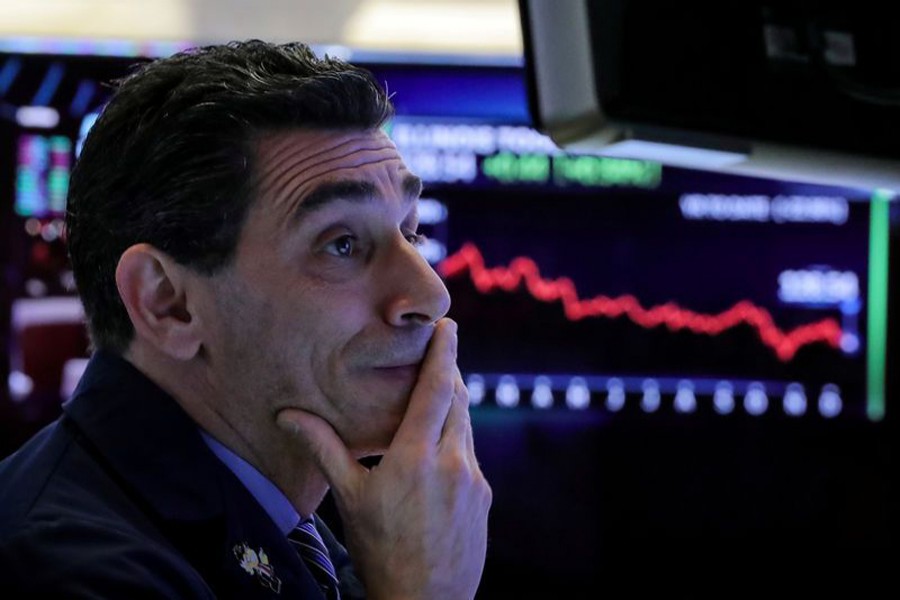A gauge of stocks worldwide posted an eighth straight decline on Monday as investors ignored Trump administration attempts to reinforce confidence and the US president called the Federal Reserve the “only problem our economy has.”
Investors, also facing the likelihood of a prolonged US government shutdown, fled to the relative safety of bonds and gold during the first day of a week of trading shortened by the Christmas holiday.
Oil prices, meanwhile, tumbled more than 6 per cent on Monday to the lowest in over a year.
On Sunday, President Donald Trump’s Treasury secretary responded to the ongoing selloff by calling top US bankers and said he would convene a group of officials known as the “Plunge Protection Team.”
“There are a whole number of factors that have triggered this latest risk-off climate, including the Fed’s very modest deviation from its (rate increase) plan and the government shutdown in the United States,” said Investec economist Philip Shaw.
“We may get some clarity on several factors in early 2019, starting with a clearer line of sight on the prospect for a resolution in U.S.-China trade dispute, but until then, there are some nerves.”
MSCI’s world equity index .MIWD00000PUS, which tracks shares in 47 countries, was 1.57 per cent lower and down 8 per cent over the past eight sessions. The index touched its lowest since early 2017.
US stocks have fallen sharply in recent weeks on concerns over slowing economic growth and efforts by the US Federal Reserve to tighten monetary policy, with the S&P 500 index .SPX on pace for its biggest percentage decline in December since the Great Depression and on the cusp of confirming it is now in a bear market. The Nasdaq .IXIC has fallen nearly 22 per cent from its August 29 high.
Trump on Monday blasted the independent US central bank, saying on Twitter that the “only problem our economy has is the Fed. They don’t have a feel for the market.”
Meanwhile, the US Senate has been unable to break an impasse over Trump’s demand for funds for a wall on the border with Mexico, and a senior official said the resulting government shutdown could continue into January.
US stocks followed broad indexes in Europe and Asia lower on Monday, with markets in Germany and Italy closed.
The Dow Jones Industrial Average .DJI fell 653.17 points, or 2.91 per cent, to 21,792.2, the S&P 500 .SPX lost 65.52 points, or 2.71 per cent, to 2,351.1 and the Nasdaq Composite .IXIC dropped 140.08 points, or 2.21 per cent, to 6,192.92.
“Markets (are) still under pressure from last week’s more hawkish Fed update, exacerbating fears about slowing growth and more expensive refinancing following years of stimulus,” said Mike van Dulken, head of research at Accendo Markets.
The political uncertainty has only added to the air of risk aversion, with benchmark 10-year Treasury notes US10YT=RR rising 14/32 in price to yield 2.7418 pe rcent.
The gap between two and 10-year yields has shrunk to fewer than 0.15 percentage point, a flattening of the curve that has sometimes heralded coming recessions in the past.
“Many of the financial and economic indicators that turn first around business cycle peaks are now flashing red in advanced economies,” said Simon MacAdam, global economist at Capital Economics.
“This is consistent with our view that the recent loss of momentum in the world economy will develop into a more severe slowdown in 2019.”
The flight to safe havens again boosted the yen, with the dollar hitting its lowest level against the Japanese currency since August. The yen JPY= strengthened 0.81 per cent versus the greenback at 110.33 per dollar, according to Reuters news agency.
Gold also has regained its appeal, holding near six-month highs XAU= over $1,268 per ounce.
Brent crude futures LCOc1 were down $3.02 a barrel at $50.80. US crude futures CLc1 fell $2.94 to trade at $42.65.
Brent fell 11 per cent last week and hit its lowest since September 2017, while US futures slid to their lowest since July 2017, bringing the decline in the two contracts to 35 per cent so far this quarter.


